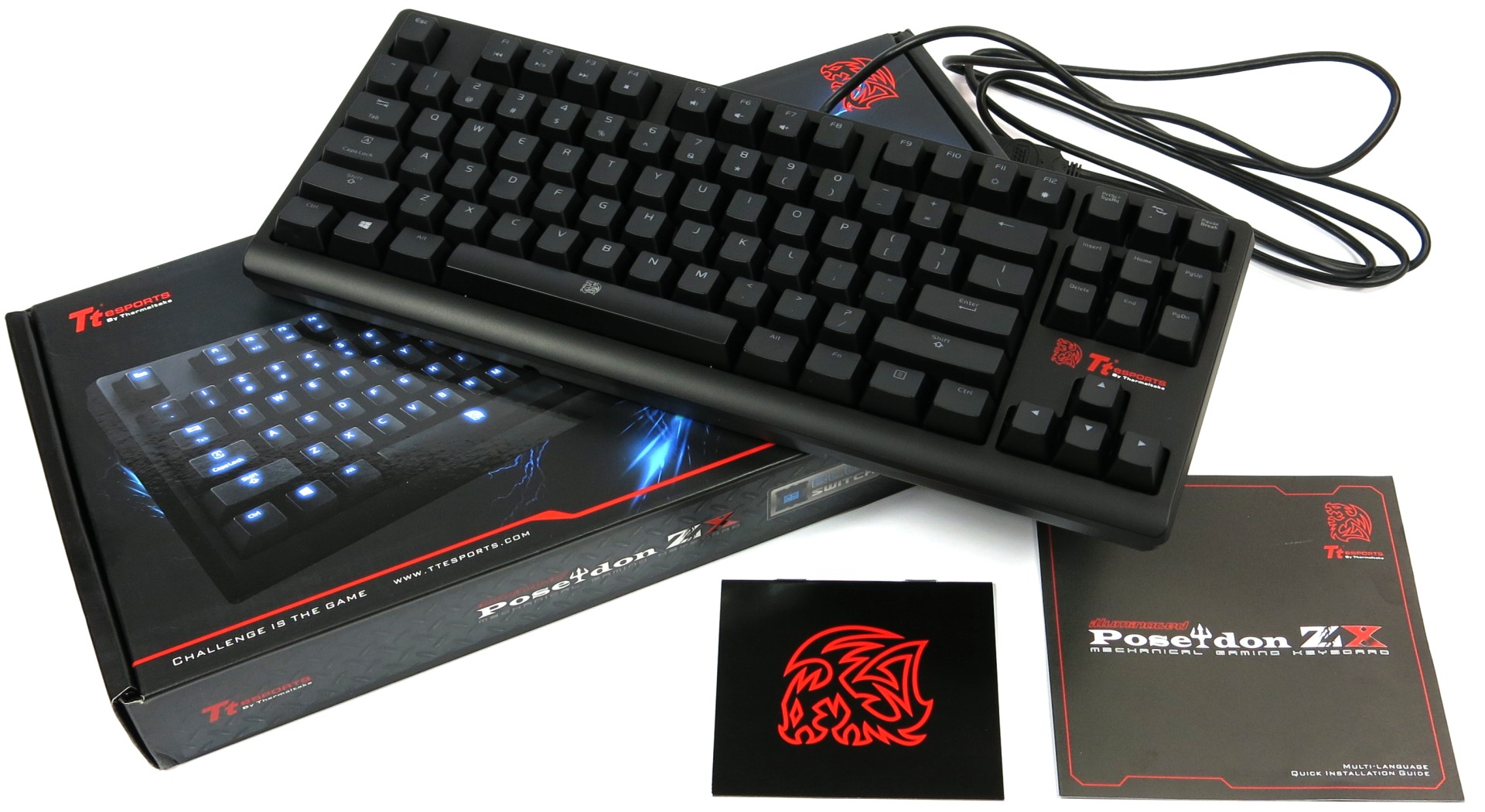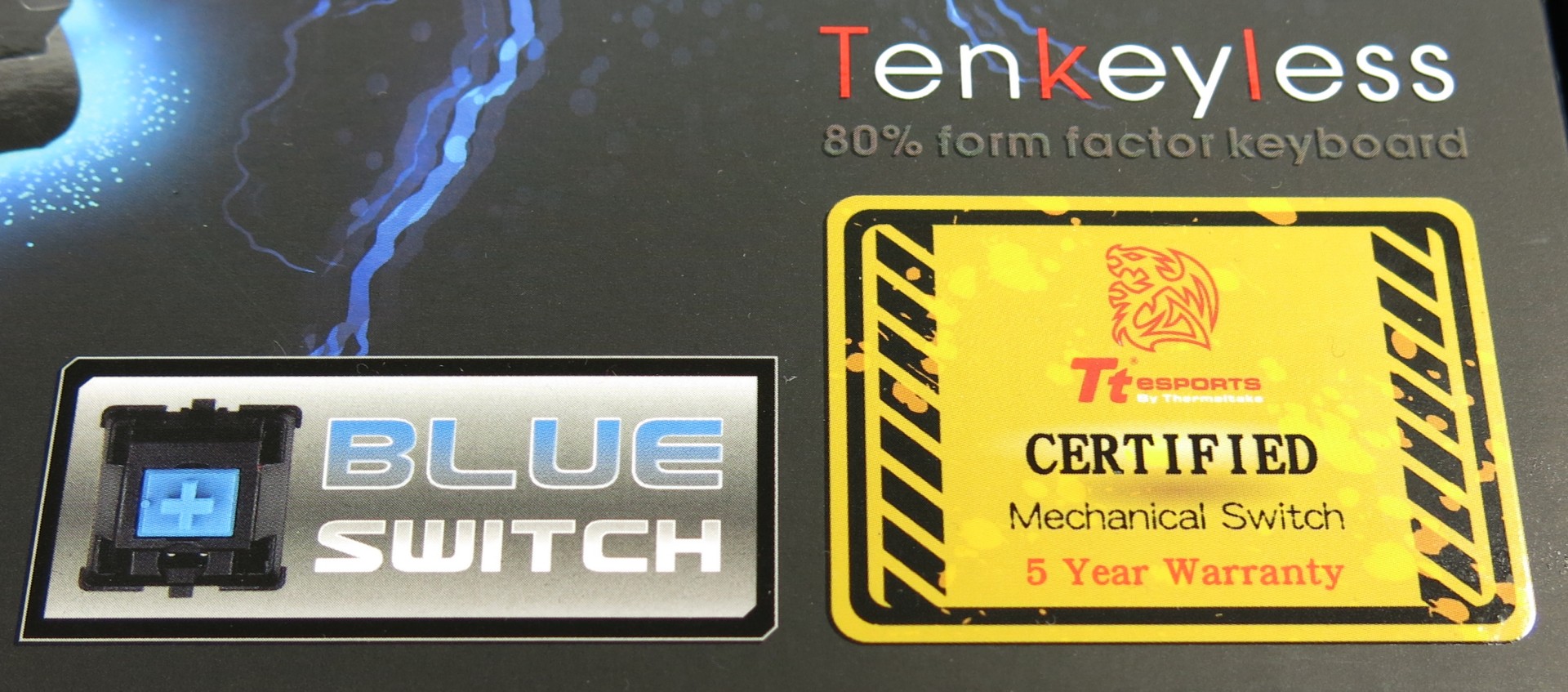Tt eSports by Thermaltake Poseidon ZX Review
Terms like “tenkeyless” and “80% form factor” mean simply, a keyboard without the number pad — and this format isn’t just popular with gamers.
Introducing the Tt eSports by Thermaltake Poseidon ZX
As opposed to the “full” Poseidon Z, the Poseidon ZX doesn’t have a numeric keypad and is consequently 20 percent smaller than traditional keyboards. This can often be a very practical form factor, like when a bit more space for the mouse would come in handy on a smaller desk or when a workstation is limited to a width of 19 inches.

Tt eSports by Thermaltake settled on Kailh switches instead of Cherry ones for the Poseidon ZX. This decision is probably due to price, since the availability of Cherry switches made by ZF Friedrichshafen AG in Germany isn’t really a problem anymore.
You can say what you want about the Cherry knockoffs, but at least they seem to have the problems with the first batches they made under control. We’ll talk about these switches in more detail later in their own section. Suffice it to say here that Tt eSports by Thermaltake has a 5-year warranty on the mechanical switches, which makes the fact that the company didn’t use the original switches a lot less relevant for the buyer.

We’ve received our keyboard directly from Tt eSports by Thermaltake’s headquarters. We’ll take a look if, and for whom, this board makes sense.
| Technical Specifications | |
|---|---|
| Keyboard Dimensions | 36.3 x 14.3 x 4 cm |
| Wrist Rest | None |
| Weight | 970 g (Manufacturer's Specifications)940 g (Measured without Cable) |
| Memory | Not Stated |
| Features | Anti Ghosting and Anti Jamming 6KRO |
| Multimedia Keys | Present, Can Be Activated via Function Keys (Sound and Media Player)Windows Key Can Be Turned Off |
| Macro Keys | None |
| Connection Type | USBPolling Rate 1000 Hz (1 ms) |
| Switch Type | Kailh (Blue) |
| Lighting | Each Key Has Its Own Blue LED4 Brightness Levels, Can Be Turned Off Completely |
| Key Caps | Cylindrical Key Design (Good Protection against Sliding Off Sides)Coated, Keys Recessed |
| Accessories | Quick Starter |
| Layout | U.S. (Others Available) |
| Cabling | 2 m USB CablePlastic Sleeve |
Stay On the Cutting Edge: Get the Tom's Hardware Newsletter
Get Tom's Hardware's best news and in-depth reviews, straight to your inbox.
Current page: Introducing the Tt eSports by Thermaltake Poseidon ZX
Next Page Look and Feel, Usability and Functionality-
DarkSable You talk about the advantages of it not having a numberpad, but not about the disadvantages.Reply
1) It's significantly slower to type numbers or serial codes. In other words, for a whole bunch of the office work that you're saying it's so good for.
2) It means you can't use a program like autohotkey to turn the number pad into a macro pad.
3) All you say is that if you can live without one and that you shouldn't hesitate to switch to tenkeyless... You're making it out as though it's a BAD thing to have a keyboard with extra functionality, when it's absolutely not. -
itzsnypah In this price range ($80) I would rather buy a Cooler Master Quickfire Rapid. It's a rebranded Flico unit with real CherryMX switches. And I get a choice of switches.Reply -
dovah-chan No Corsair K65 mention? And I thought it was the best tenkeyless out there. Sure it might not have your flashy LEDs but it has a solid build quality and simplistic looks. Speaking of LEDs I own a Corsair K70 with the blue LEDs and I don't ever use them anyway because they look silly.Reply
But really if you're that hard pressed for space then just get a bigger desk or a laptop please. The number pad has many unsung properties and is quite useful for any user in a variety of situations. -
Dogsnake A Numeric pad is essential to me. Even in everyday home use a separate number entry is helps. The thing is that I use my right hand on the mouse. Keyboards with reversible numeric sections have all but disappeared and there are none combined with a quality mechanical key setup. There are however a number (sic) of third party ad-on numeric pads. The advantage too is that you can move them around and choose your placement even on a crowded or smaller desktop. I think the question here is if this is a quality keyboard with durability? I agree the price is a bit steep given the many alternatives on the market.Reply -
nezzymighty ReplyYou talk about the advantages of it not having a numberpad, but not about the disadvantages.
1) It's significantly slower to type numbers or serial codes. In other words, for a whole bunch of the office work that you're saying it's so good for.
2) It means you can't use a program like autohotkey to turn the number pad into a macro pad.
3) All you say is that if you can live without one and that you shouldn't hesitate to switch to tenkeyless... You're making it out as though it's a BAD thing to have a keyboard with extra functionality, when it's absolutely not.
DarkSable, I agree with you... it is all subjective... this is no longer a "News" report, but rather an advertisement... it favors an opinion rather than reporting facts... a lot of articles have been trending this way...
Many companies/industries pay writers to mix opinions to sway to a particular product in their favor. I think they're termed kick-backs. They defend positions with true facts, and willfully neglect others that would otherwise be a deficiency, as you pointed out.
Point in-case mechanical keyboards are not exclusive to the gaming demographics (which I believe Thermaltake, with Tom's help is hoping to impress).
There's a lot of great information provided by Tom's to the masses. The question is, do they want to be the Time Magazine of the technology industry, or do they want to become it's National Inquirer? -
zanny I have a Quickfire Rapid from 2010. I intentionally avoided the keypad, and I like it much better. Being able to position the mouse and keyboard closer makes it much easier to switch between typing and mouse + keyboard work, and if I want a numpad I can always get a usb numpad.Reply -
dovah-chan Reply14098355 said:You talk about the advantages of it not having a numberpad, but not about the disadvantages.
1) It's significantly slower to type numbers or serial codes. In other words, for a whole bunch of the office work that you're saying it's so good for.
2) It means you can't use a program like autohotkey to turn the number pad into a macro pad.
3) All you say is that if you can live without one and that you shouldn't hesitate to switch to tenkeyless... You're making it out as though it's a BAD thing to have a keyboard with extra functionality, when it's absolutely not.
DarkSable, I agree with you... it is all subjective... this is no longer a "News" report, but rather an advertisement... it favors an opinion rather than reporting facts... a lot of articles have been trending this way...
Many companies/industries pay writers to mix opinions to sway to a particular product in their favor. I think they're termed kick-backs. They defend positions with true facts, and willfully neglect others that would otherwise be a deficiency, as you pointed out.
Point in-case mechanical keyboards are not exclusive to the gaming demographics (which I believe Thermaltake, with Tom's help is hoping to impress).
There's a lot of great information provided by Tom's to the masses. The question is, do they want to be the Time Magazine of the technology industry, or do they want to become it's National Inquirer?
I do too feel like this one is just a PR news release. I would rather instead have a big lineup comparing the features and build quality of a bunch of tenkeyless boards in a similar price range (sorta like tom's does with cases sometimes) rather than just reviewing one board and sometimes mentioning other boards for a comparison.
In fact I feel like the gaming peripherals market is very under looked here at tom's. Every once in a while I might see a link to tom's guide to some random peripheral (lately it's been corsair products) but that's it. Everything else is just news of a new product coming out from X company.
Why don't we just have a yearly keyboard and mouse lineup? Maybe have an article for the keyboard reviews and the mice reviews. In each article they would choose 15 products and divide them by three sections each containing five peripherals: Budget tier ($0-$20~), Mid tier ($30-$90), and High end ($100+).
So it would go like this:
Budget Tier- Logitech K120
- Corsair Raptor K30
- Rosewill RK-8100
- CM Storm Devastator
- Gigabyte Force K3
Mid Tier- Corsair Raptor K40
- Razer Deathstalker
- Microsoft Sidewinder X4
- Logitech G105
- Steel Series Apex
High End- Logitech G19s
- Razer Blackwidow Ultimate 2014 Edition
- Corsair K70
- Ducky Channel Shine III
- Rosewill RGB80
And in each category you would first give us a brief introduction to each board (packaging, features, build quality, included software,functionality, etc.) then compare each board by assessing the value of it and how useful the features are alongside the quality of the product's presentation. Then on the next article you just do the same thing but with mice. If you want I'll give you a tier list of mice as well.
The bottom line is that I would love an article like that. I would also ADORE tom's if they were to cover the topic of companies that produce mice sensors such as avago and pixart. Other good things to mention would be the misinterpretation of DPI and acceleration, flawless sensors (might require a bit of extensive testing), and mice switches (aka left and right MB). Just some ideas from a loyal reader. -
Zepid If you don't use a tenkey in your day to day computer use, then frankly you aren't buying this with your own money. Be a good kid and don't waste your parents' money on what amount to luxury items.Reply
That said I love my Ducky keyboard with green switches. I couldn't live without the tactile feedback and hypnotic click. -
FormatC @dovah-chan:Reply
This review from me was published on German site first. We have there a lot of such reviews so it doesn't look like advertising. We have simply more bandwith in some kind of periphery:)
I'm using each product about I wrote for a longer period by myself to make a real-world test. Only 1 hour of usage ist too less for an objective conclusion ;)